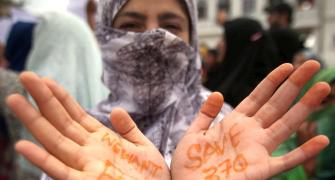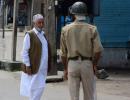'The manner in which assembly seats were distirbuted among Jammu, Kashmir and Ladakh so far, has ensured that residents of the Valley rule the state forever,' says Sanjeev Nayyar.

The passage of the Jammu and Kashmir Reorganisation Bill, 2019 by Parliament has cleared the path for setting up of a new delimitation commission in the Union territory of Jammu and Kashmir that will also have a legislative assembly.
The new state assembly shall have 114 seats (currently 107), out of which only 90 will be open for elections, and the remaining 24 will be shadow seats reserved for the areas of the erstwhile state that have been occupied by Pakistan (PoJK).
Delimitation literally means the process of fixing limits or boundaries of territorial constituencies in a state that has a legislative body.
For the delimitation exercise, the population figures of 2011 census shall be taken as the basis.
The J&K Representation of the People Act 1957 has now been invalidated and, instead, delimitation will be done as per the Representation of the People Act, 1950 (as amended from time to time) and provisions of Sections 59, 60 of Act 34 of 2019.
Going forward, it is important to recall how the assembly seats in J-K were decided and to highlight the anomalies in census numbers.
The table below shows the state's area (excluding areas occupied by China and Pakistan), number the of seats and region-wise population. No census was done in 1991.
| Region | Area (sq km) | No. of seats | 1961 | 1971 | 1981 | 2001 | 2011 |
| Valley | 15,948 | 43 | 1,899 | 2,436 | 3,135 | 5,477 | 6,888 |
| Jammu | 26,293 | 30 | 1,572 | 2,076 | 2,718 | 4,430 | 5,379 |
| Ladakh | 59,146 | 2 | 90 | 105 | 134 | 237 | 274 |
| Total | 1,01,387 | 75 | 3,561 | 4,617 | 5,987 | 10,144 | 12,541 |
(Population figures in thousands. Source: Religious Demography of India by Dr M D Srinivas, Ashok Joshi and Dr J K Bajaj)
Thus, in 1961, there was one assembly seat per 370 square km in Kashmir as against per 876 sq km in Jammu.
How many districts existed in J-K in October 1947?
Jammu province had five -- Jammu, Kathua, Udhampur, Reasi and Mirpur, and two jagirs: Poonch, Chenani; Kashmir had three districts, viz, Anantnag (Srinagar was a tehsil of Anantnag), Baramulla and Muzaffarabad.
After its 1947 intrusion, Pakistan occupied the districts of Mirpur and Muzaffarabad.
Was any census conducted in 1951 before deciding the electoral districts?
No.
What was the basis for allocating seats among Jammu, Kashmir and Ladakh regions?
Yuvraj Karan Singh issued a proclamation on May 1, 1951, that the state shall be divided into a number of territorial constituencies, each with a population of 40,000 or as near thereto as possible, and each electing one member.
Thus 100 seats were decided (Kashmir having 43, Jammu 30 and Ladakh 2) of which 25 were kept for PoJK that were not to be included, for the time being, in the effective strength of the legislative assembly till the area is vacated by Pakistan.
Since no census data was available, 100 seats were decided on the basis of assumption and method of proportions (including 25 for PoJK).
By using 40,000 people per constituency formula, the assumed population of Kashmir was 17.2 lakh, Jammu 12 lakh and Ladakh 80,000.
This assumption was fallacious because according to the 1941 Census (Administrative report, October 1941, the Maharaja's government), the population of Jammu was 20 lakh, Kashmir 17.3 lakh and Ladakh/Gilgit etc 3.1 lakh (the population of undivided J-K 40.4 lakh).
Thus, Jammu's population was assumed to be 12 lakh against the actual 20 lakh.
Further, the 1941 census numbers needed adjustment, as Muzaffarabad and Mirpur districts became part of PoJK post October 1947.
The population of Kashmir was not reduced by the population of Muzaffarabad district and that of Jammu was also not reduced by the population of Mirpur district.
Conversely, the population of Jammu was not increased by the displaced families of PoJK, most of whom settled outside the Kashmir Valley.
Thus, the number of seats given to Jammu were clearly understated.
Further, even if one were to ignore the anomalies in population referred to above and took just for reference sake the 1941 census as a basis, the population per assembly seat was 66,718 for Jammu's 30 seats vs 43,217 for Kashmir's 40 seats.
This ad hoc allocation of 43 seats to Kashmir in 1951 needed correction.
This was in a way suggested by the Constituent Assembly, when Section 50 of the J&K Constitution (1957) was incorporated, which laid down the elected MLCs for unoccupied areas of Jammu at 14 and for Kashmir at 12.
Hence, the basis on which 43 seats were given to Kashmir and 30 to Jammu in 1951 remains under question.
What were the results of the 1951 election?
The National Conference won all the 75 seats.
Was population the only basis for deciding the number of seats?
The Representation of the People Act, 1951 lays down only population as the basis for determining the number of constituencies.
However, the J&K Representation of People Act, 1957 laid down additional criteria, namely, geographical compactness (distribution of people in Kashmir is compact as compared to Jammu and Ladakh regions); nature of terrain (Jammu region has not more than 25 per cent of plain terrain while Valley has 75 per cent); facilities for communication (percentage of area covered by roads in Valley was almost 2.5 times when the last exercise for delimitation was concluded in 1995); and other similar factors.
However, single member assembly seats were never allocated on the above basis.
It would not be out of place to mention that when Sheikh Abdullah came to power in 1975, Jammu had six districts vs Kashmir's three.
He created three more districts in Kashmir in 1979, thereby increasing the number to six while the number of districts in Jammu remained the same.
For Ladakh, the number of districts went up from one to two.
What is the population per assembly seat and were the number of seats increased in 1995?
In 1987, the total number of seats were increased -- by a constitutional amendment -- from 100 to 111 and for election purposes from 76 to 87.
The delimitation order was issued on that basis in 1995 again, erroneously increasing seats from 42 to 46 for Kashmir and from 32 to 37 for Jammu.
This was done in defiance of the parameters/guidelines laid down in J&K Representation of the People Act 1957. Ladakh's seats were increased from two to four.
Should the Delimitation Commission appointed under the Jammu and Kashmir Reorganisation Act, 2019 make amends?
Yes. The contents of Section 60 do show such an intent. In fact, the bill even reiterates the four criteria laid down in the J&K Representation of People Act, 1957 as referred to above.
The key provisions of Sections 59 and 60 of the Reorganisation Bill, 2019 are that all constituencies a) shall be single-member constituencies; b) all constituencies shall, as far as practicable, be geographically compact areas, and in delimiting them, regard shall be had to physical features, existing boundaries of administrative units, facilities of communication and conveniences to the public, and; c) constituencies in which seats are reserved for the Scheduled Castes and the Scheduled Tribes shall, as far as practicable, be located in areas where the proportion of their population to the total population is the largest.
To understand how big Jammu is, note that the maximum drivable distance is about 480 km, ie, from Poonch to Sinthan Top via Jammu, whereas that in Kashmir is about 135 km.
Should the abnormal increases in number of voters in Kashmir be investigated?
Yes.
| Region |
2001 census |
2011 census | 2002 assembly voters | 2008 assembly voters | 2014 Lok Sabha voters |
| Kashmir | 54.77 | 68.88 | 28.85 | 32.63 | 35.97 |
| Jammu | 44.30 | 53.79 | 30.26 | 31.15 | 31.76 |
| Ladakh | 2.37 | 2.74 | 1.74 | 1.59 | 1.60 |
| Total | 101.44 | 125.41 | 60.85 | 65.37 | 69.33 |
The unusual increase in voters in Kashmir must be probed.
During 2001-11, the state's population went up by 23.6 per cent, while during 2002-14, the number of voters rose by 14 per cent.
In absolute terms, the population in Kashmir between 2001 and 2011 went up by 14.11 lakh (25.8 per cent), while the increase in number of voters between 2002 and 2014 was 24.7 per cent (7.12 lakh).
The corresponding figures for Jammu are 21 per cent and 5 per cent. So, the percentage rise in voters in Kashmir was 24.7 per cent, against only 5 per cent in Jammu!
Note that in 2002, the number of voters in Jammu was more than in Kashmir by 1.41 lakh; in 2014, Kashmir exceeds Jammu by 4.21 lakh, ie, a swing of 5.67 lakh.
Suggestions for the Delimitation Commission
Daya Sagar, a Jammu-based freelance journalist and keen observer of J-K affairs, says, "It is now hoped that a fair delimitation will be done before holding elections in terms of the parameters laid down in the 2019 Reorganisation Act (Act No.34 of 2019).
"Since there is reference of district boundaries too in the parameters mentioned in Section 60 of the Act, the two very unfair reorganisations of district administrative units in the state, particularly in 1979 and 2006, need to be revisited.
"So even before a delimitation commission is appointed or takes up work, there is a need to reorganise the district administrative units keeping in view that before 1979, Kashmir had three districts (spread over less than 16,000 sq km) while Jammu had six (spread over more than 26,000 sq km), so that any illusions that existing number of districts may cause while making the review is also removed."
What is the way forward?
Besides the above, a detailed analysis of the voters list needs to be made. The government must map the voter lists with Aaadhar cards.
Rohingyas and Bangladeshis must not be part of any voter list.
It would be fair to say that the manner in which the number of assembly seats had so far been decided was an attempt to ensure that residents of Kashmir Valley ruled J-K forever.
Sanjeev Nayyar is a chartered accountant and founder, www.esamskriti.com. He tweets @NayyarSanjeev.









